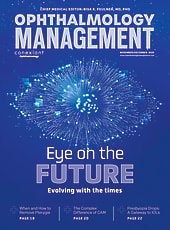Compliance in health care is a critical component of delivering quality care while adhering to legal and ethical standards. For ophthalmic practices, there is an array of requirements spanning privacy policies, billing transparency, accessibility, communication assistance, and workplace notices. From the HIPAA Privacy and Security Rules to the Americans with Disabilities Act (ADA) and the No Surprises Act, these regulations are designed to ensure patient rights and accessibility. This article outlines the key posting and the communication obligations that ophthalmic practices must meet to maintain compliance, improve patient and staff satisfaction, and avoid penalties.
HIPAA
The HIPAA Privacy Rule1 requires the provision of the practice’s privacy policy as a notice: A covered entity must prominently post and make available its notice on any website it maintains that provides information about its customer services or benefits. The practice must also make the latest notice (i.e., the one that reflects any changes in privacy policies) available at the provider’s office or facility for individuals to request to take with them, and post it in a clear and prominent location at the facility.
No Surprises Act
The No Surprises Act2 is a federal law that took effect on January 1, 2022, restricting many instances of “surprise” medical bills: A provider or facility must disclose to any participant, beneficiary, or enrollee in a group health plan or group or individual health insurance coverage to whom the provider or facility furnishes items and services information regarding federal and state (if applicable) balance billing protections and how to report violations. Providers or facilities must post this information prominently at the location of the facility, post it on a public website (if applicable) and provide it to the participant, beneficiary or enrollee in a timeframe and manner outlined in regulation.
Optical
Retail optical shops that bill durable medical equipment, prosthetics, orthotics, and supplies (DMEPOS)3 to Medicare must comply with CMS’ supplier standards. Such standards include that the optical, (C) Is accessible and staffed during posted hours of operation. (D) Maintains a permanent visible sign in plain view and posts hours of operation. If the supplier’s place of business is located within a building complex, the sign must be visible at the main entrance of the building or the hours can be posted at the entrance of the supplier.
ADA Website Compliance
The ADA4Title III prohibits discrimination against people with disabilities by businesses open to the public (also referred to as “public accommodations” under the ADA). The ADA requires that businesses open to the public provide full and equal enjoyment of their goods, services, facilities, privileges, advantages, or accommodations to people with disabilities. Businesses open to the public must take steps to provide appropriate communication aids and services (often called “auxiliary aids and services”) where necessary to make sure they effectively communicate with individuals with disabilities.
For health care practices, auxiliary website aids include posting buttons that users can click to enlarge the website font, adjust contrast, video captions, etc. Find current accessibility standards in the WCAG 2.2.5
Limited English Proficiency
Section 1557 of the Affordable Care Act6 establishes guidelines for Limited English Proficiency (LEP) compliance, requiring covered entities to display notices informing individuals of their rights and the availability of communication assistance. These notices must be prominently placed in physical locations where the entity interacts with the public and on the entity’s website, accessible from the homepage. Additionally, covered entities must provide taglines in the top 15 languages7spoken by individuals with limited English proficiency in their state, indicating the availability of language assistance services.
Labor Laws
Some of the statutes and regulations enforced by the U.S. Department of Labor (DOL) require that notices be provided to employees and/or posted in the workplace. DOL provides free electronic copies of the required posters and some of the posters are available in languages other than English.8Federal9and state10 requirements will vary.
Conclusion
In summary, ensuring compliance in 2025 requires ophthalmic practices to address many regulations, including HIPAA Rules, the No Surprises Act, optical standards, ADA website accessibility, LEP, and labor law requirements. By proactively addressing these posting and communication requirements, practices can enhance patient and staff experiences while avoiding potential regulatory penalties. OP
References
1. U.S. Department of Health and Human Services. Privacy practices for protected health information. HHS.gov. Updated March 26, 2013. https://www.hhs.gov/hipaa/for-professionals/privacy/guidance/privacy-practices-for-protected-health-information/index.html. Accessed Feb. 4, 2024
2. Centers for Medicare & Medicaid Services. High-level overview of provider requirements. CMS.gov. Published June 2021. https://www.cms.gov/files/document/high-level-overview-provider-requirements.pdf. Accessed Feb. 4, 2024
3. Centers for Medicare & Medicaid Services. DMEPOS supplier standards. CMS.gov. https://www.cms.gov/Medicare/Provider-Enrollment-and-Certification/MedicareProviderSupEnroll/downloads/DMEPOSSupplierStandards.pdf. Accessed Feb. 4, 2024
4. U.S. Department of Justice. Guidance on web accessibility and the ADA. ADA.gov. https://www.ada.gov/resources/web-guidance/. Accessed Feb. 4, 2024
5. World Wide Web Consortium (W3C). Web content accessibility guidelines (WCAG). https://www.w3.org/WAI/standards-guidelines/wcag/. Accessed Feb. 4, 2024
6. U.S. Department of Health and Human Services. Section 1557 of the Patient Protection and Affordable Care Act: guidance on language access. https://www.hhs.gov/sites/default/files/ocr-dcl-section-1557-language-access.pdf. Accessed Feb. 4, 2024
7. U.S. Department of Health and Human Services. Resources for covered entities. https://www.hhs.gov/civil-rights/for-individuals/special-topics/limited-english-proficiency/index.html#lep-resources. Accessed Feb. 4, 2024
8. U.S. Department of Labor. Workplace posters. https://www.dol.gov/general/topics/posters. Accessed Feb. 4, 2024
9. U.S. Department of Labor. elaws Poster Advisor. https://webapps.dol.gov/elaws/posters.htm. Accessed Feb. 4, 2024
10. U.S. Department of Labor. State Resources. https://www.dol.gov/general/topic/stateresources. Accessed Feb. 4, 2024









